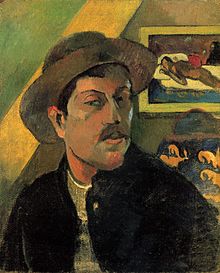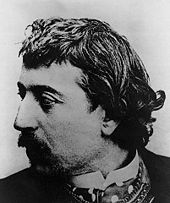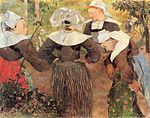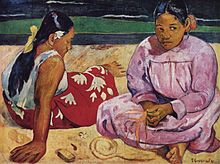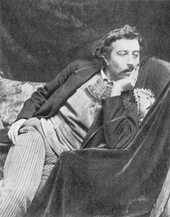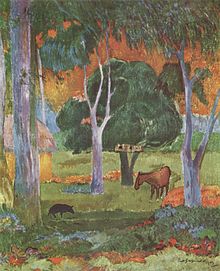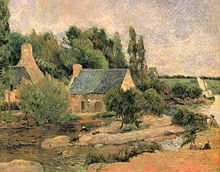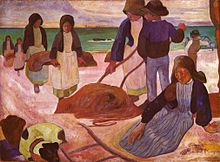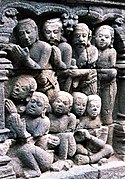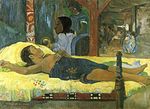Paul Gauguin
Eugène Henri Paul Gauguin [ øʒˌɛn ɑ̃ˌʁi ˌpol ɡoˈɡɛ̃ ] (born June 7, 1848 in Paris , † May 8, 1903 in Atuona on Hiva Oa , French Polynesia ) was an influential French painter . In addition, he made ceramics, wood carvings and woodcuts. He was best known for his paintings from the South Seas . Gauguin's post-impressionist work strongly influenced the Nabis and Symbolism ; he was a co-founder of Synthetism and became a pioneer of Expressionism . With that he played an important role in the development of European painting.
Childhood and youth
Gauguin's father Clovis Gauguin (1814-1851) was a liberal journalist, his mother was Aline Marie Chazal (1825-1867), the daughter of the socialist writer Flora Tristan , a French woman with Peruvian roots. Soon after the birth of the son, during the February Revolution of 1848 , the father was forced to leave France for political reasons. In 1849 the family embarked for Peru, where Gauguin's mother had influential relatives and where the father was planning to start a newspaper. However, he died of a heart attack on the crossing. In the following years his wife lived with their two children - Paul and his older sister - with their uncle in Lima . After civil war broke out in Peru in 1853, the family returned to France.
Gauguin attended a boarding school, the Petit Séminaire de la Chapelle-St-Mesmin, near Orléans . One of his teachers there was Bishop Félix Dupanloup , who taught him Catholic liturgy and philosophy. In the meantime, however, he also lived for a few months with his mother, who had opened a tailoring salon in Paris; Gauguin attended a naval school there. At the age of 17 his "fad to flee", as he himself put it, made him pursue a career as a seaman. In 1865 he joined the merchant navy as an officer candidate , and later switched to the navy . In this way he came to South America and India and crossed the Arctic Circle on a research trip. In 1867, when Gauguin was on a long journey, his mother died. She had appointed a family friend, Gustave Arosa, as guardian for Paul. Gauguin ended his career as a seaman in 1871.
Civil career
On the mediation of Gustave Arosa, Gauguin took a job in a bank in 1872. It was surprisingly easy for him to find his way into the new situation. He made good money as a stockbroker, was also successful in speculating on his own account and was soon able to afford a luxurious lifestyle. In 1873 he married Mette-Sophie Gad from Denmark, with whom he later had five children.
Guardian Gustave Arosa was not only a businessman, he was also an art lover and collector. In his house Gauguin got to know works by Eugène Delacroix , Gustave Courbet and Camille Corot , among others . Inspired by this, Gauguin took lessons and began to paint himself in his spare time. In 1876 he succeeded for the first (and only) time in exhibiting a painting in the Paris Salon : Sous-bois à Viroflay , a landscape in the typical painting style of the Barbizon school . In 1879 he was invited to take part in the fourth group exhibition of the Impressionists . In the same year he visited the impressionist painter Camille Pissarro at his country estate to paint outdoors under his guidance. Gauguin also took part in four other so-called Impressionist exhibitions. He made the acquaintance of numerous Impressionist artists, including Edgar Degas , Pierre-Auguste Renoir and Édouard Manet , and began to collect their works.
Decision to paint
In 1882 Gauguin lost his job as a result of a stock market crash and took this as an opportunity to give up the banking profession entirely. Against the resistance of his wife, he decided from now on only to paint and to earn a living for the family. Gauguin had expected that his painting would quickly establish himself, but was only able to finance a modest livelihood in the last years of his life. His moodiness and belligerence did nothing to help him get on. From now on, his life was marked by constant financial worries. In addition to selling pictures, he lived on donations from friends, from auxiliary work, and temporarily also from a small inheritance.
In 1884 the family moved to Rouen in Normandy because the standard of living there was lower, but a few months later the wife and children returned to their family in Copenhagen . Gauguin also went there towards the end of the year; his plan to establish himself there as a representative of a canvas company failed. After an unsuccessful exhibition of his works and violent arguments with Mette's family, he finally returned to Paris, where he led an unsteady wandering life from then on. Despite the split, the couple stayed in correspondence until shortly before Gauguin's death.
Brittany, Caribbean and Arles

In 1886 he went to Pont-Aven for three months . The Breton fishing village was a popular meeting place for artists, later known as the Pont-Aven School . Gauguin's work was recognized by fellow painters. "I work here a lot and with great success," he wrote to his wife. "I am respected as the strongest painter here, but that doesn't bring me a single sou [...] I live on credit, and the financial worries make me feel completely despondent." Back in Paris, he began to produce ceramics together with a potter . The imaginatively decorated vessels reflect the influence of pre-Columbian ceramics, which Gauguin had known since his childhood in Peru. The hoped-for financial success did not materialize here either. Towards the end of the year he met his brother Vincent van Gogh through the Parisian art dealer Theo van Gogh .
One of the reasons for Gauguin's stay in Brittany was his search for a simple, original life. In 1887 this search took him further afield: together with his artist friend Charles Laval, he embarked for Panama in April . "[...] I'm going to Panama to live like a savage there," he wrote to Mette Gauguin in early April 1887. However, the reality turned out to be disappointing. Gauguin's financial troubles came to a head that he was forced to hire himself out as a laborer building the Panama Canal . In June, the two painters traveled on to another supposed paradise: "[...] a beautiful country with an easy and cheap life - that's Martinique, " wrote Gauguin to his friend Émile Schuffenecker . At first Gauguin was enthusiastic about the lush nature of Martinique. But he soon fell ill with dysentery and malaria , so that he was forced to return to France in November, where he recovered only slowly . Despite all the difficulties, the stay was artistically successful; Gauguin brought home more than twenty paintings.
For the next three years Gauguin commuted between Paris and Brittany . There he became the focus of a small group of artists, some of whom would later become known as the Nabis . Together with Émile Bernard he developed a new style, synthetism .
In October 1888, Gauguin followed Vincent van Gogh's suggestion to live and work with him in Arles in the south of France . The conflict-laden relationship ended two months later with the never-fully resolved incident that van Gogh cut off a piece of his ear after an argument. Gauguin escaped from the unbearable situation to Paris. From February 1890 he taught at the Académie Vitti for a few months .
First stay in Polynesia
Since the late 1880s, Gauguin had toyed with the idea of living and painting in the tropics. At first he wavered between the islands of Madagascar and Tahiti , but finally decided on the latter. In Gauguin's imagination, Tahiti was an exotic paradise where he would be able to lead an original, happy and almost free life without having to work. The “happy inhabitants of a neglected paradise in Oceania know nothing of life other than its sweetness. For them, life means singing and loving, ”he wrote to the Danish painter Jens-Ferdinand Willumsen at the end of 1890.
A fairly successful auction of his paintings paid for the travel expenses, and in April 1891 Gauguin embarked for Tahiti. Once there, he found that reality in no way coincided with his expectations. Christianization , trade and colonial rule (Tahiti had been a French colony since 1880) had destroyed the "exotic paradise", if it had ever existed. In the capital, Papeete , the local population lived in poor corrugated iron huts, western clothing had replaced traditional costumes, and religion and traditions had been suppressed by the missionaries . The way of life of the white upper class hardly differed from that in the mother country. On the run from European civilization, Gauguin rented a hut in the village of Mataiea, 40 km from Papeete. He learned - with moderate success - the national language. He soon lived with the 13-year-old Tahitian Téha'amana (also known as: Tehura), who often served as a model for him. Numerous paintings with Tahitian motifs were created. However, they do not reflect the Tahiti that surrounded Gauguin, but the colorful, exotic world that he had dreamed of.
During this stay, Gauguin began work on his book Noa Noa (Scent). In this description of his life in Tahiti, experiences are mixed with inventions; It was also his intention to use the book to arouse understanding for his art among the European public. Noa Noa , which Gauguin illustrated himself, appeared in 1897.
In early 1892, Gauguin spat blood and was admitted to the Papeete hospital, which he soon left for lack of money. In addition to the health problems, there were also financial ones. The money he had brought with him was used up, and under the pressure of circumstances, Gauguin decided to return to France. He also hoped that the 66 paintings he created in Tahiti would finally bring him his breakthrough as a celebrated artist. In August 1893 he was back in Paris; the French state paid the travel expenses.
Soon after Gauguin's return, there was an exhibition of his paintings. It was highly praised by artist friends and a group of writers, but was again met with incomprehension and ridicule in the wider public.
In 1894, an inheritance made it possible for Gauguin to rent a larger studio, which he decorated in an exotic way and in which he lived with a woman of mixed ethnicity. That same year he broke his ankle in a brawl in Brittany. The injury never completely healed. Back in Paris, he found that his lover had cleared out his studio - with the exception of the pictures - and had disappeared. More failures followed, and at the end of 1894, disappointed and bitter, Gauguin decided to turn away from the civilized world and return to Tahiti.
Second stay in Polynesia and death
Gauguin returned to Papeete in September 1895; He was disappointed to find that the Europeanization of the island had meanwhile progressed further. With the help of his neighbors, he built a traditional hut on the coast near Papeete and lived again with a very young girl, Pau'ura a Tai. She gave birth to a daughter in late 1896 who died soon after. When she returned to her parents' home in 1899, she gave birth to a son, Emile.
Soon after arriving, Gauguin's health deteriorated. In addition to the pain in the leg, there was a rash as a result of syphilis . The financial situation was also worrying, as promised money transfers from France did not materialize. Gauguin lived on water and rice; he was desperate. In early 1897 he received the proceeds from the sale of paintings in Europe, which brought a temporary financial boost; but his health continued to deteriorate. He now also suffered from heart problems and chronic eye inflammation. The news of the death of his daughter Aline, who had died of pneumonia in Copenhagen, only added to his melancholy.
After a heart attack at the end of the year, Gauguin gathered all his strength and within four weeks painted the 139 × 375 cm picture Where are we from? Who are we? Where are we going? which has a testamentary character. He then attempted suicide with arsenic , the consequences of which he suffered for weeks. His health remained poor; Several times in the next few years he was forced to seek hospital treatment.
In 1898 the lack of money forced him to temporarily stop painting and instead to take a badly paid job as a draftsman at the building authority in Papeete; In 1899 he worked for the satirical magazine Les Guèpes (The Wasps); later he founded his own magazine Le Sourire (The Smile). He used both publications to campaign against officials of the colonial administration and against missionaries whom he accused of hypocrisy. Meanwhile, the art world in Europe was beginning to take notice of Gauguin's work. In 1900 he was able to conclude a contract with Ambroise Vollard , one of the most influential art dealers of his time, which secured him a modest but steady income. This was the first time the artist was able to live on the income from his painting.
Gauguin was feeling increasingly uncomfortable in Tahiti. The island seemed to him to be influenced by Europe too much, life there had become too expensive, and he was also looking for new impressions and suggestions for his painting. In autumn 1901 he moved to Atuona , the capital of the Marquesas island of Hiva Oa . The island, about 1400 kilometers (straight line Papeete-Atuona 1428 km) from Tahiti, was also part of the French colonial empire, but had retained its originality more strongly.
On Hiva Oa, Gauguin again built a hut. Again a 14-year-old girl was his partner and model at the same time: Marie-Rose Vaeoho. After separating from him, she gave birth to his daughter, Tahiatikaomata, in 1902. Gauguin stood up again for the rights and interests of the local population and attacked the Catholic Church sharply. His provocative and hurtful behavior soon brought him back into conflict with the authorities. The constant arguments finally culminated in the conviction of the artist for defamation to imprisonment and a fine that far exceeded his financial means. Gauguin was now bedridden and was fighting his pain with morphine . Before he could take any further legal action, he died at the age of 54 on May 8, 1903. He is buried on Hiva Oa.
plant
Start as an impressionist
Before he found his own way, Gauguin's painting was based on models that his surroundings offered him. He painted in the style of Impressionism, the most progressive painting style at the time, to which his painter friends and his teacher Camille Pissarro were also indebted. His paintings of this time show the characteristic features of this style, for example the blurring of shapes and the technique of placing different pure colors close together with many small brushstrokes, so that they only appear as mixed colors to the viewer from a certain distance. As with many Impressionists, his preferred subject was the landscape; the only nudes that Gauguin painted during this time, Suzanne sewing , reveals the painter Edgar Degas , whom he admired, as a model .
New forms of expression
In 1888, after his trip to the Caribbean, Gauguin began to develop a new, independent way of painting. The confrontations with his artist friends in Pont-Aven and with the works of Vincent van Gogh gave him important impulses. This process was completed in early 1891. Gauguin had now found his own imagery, which, varied in many ways, he retained until the end of his life. In literature this style is sometimes referred to as post-impressionism, then again as synthetism, also as symbolism or primitivism . Regardless of such classifications, it can generally be said that Gauguin's concern was to return to simple, original designs in his painting. He hoped that the return to the art of ancient cultures would rejuvenate and renew painting. In 1897 Gauguin, who liked to call himself a “savage”, wrote to his friend Daniel de Monfreid: “Always keep the Persians in mind, the Cambodians and a little bit the Egyptians!”
Gauguin turned away from the goal that had been pursued in painting for centuries, namely to create an illusion of reality. His pictures should not reflect the visible reality, but rather be an expression of feelings and thoughts (this is the basic idea of synthetism and symbolism; Gauguin described himself as synthetists and symbolists). He made his endeavors clear in a letter to his friend Schuffenecker dated August 14, 1888: “Don't paint too much from nature. The work of art is an abstraction. Pull it out of nature by pondering and dreaming in front of it. "
Painting style
In order to increase the impact of his paintings, Gauguin resorted to simplification. His artistic measures can be clearly seen in the picture Tang collectors (II) , created in Brittany in 1889: Gauguin reduced and simplified the forms of people and things. He no longer blurred the forms, as he did in his Impressionist phase, but clearly delimited them from one another in their different colors. Often, a darker border line emphasizes the shapes ( cloisonism ).
Gauguin also simplified the variety of colors that arise in nature through the effects of light and shadow by combining them into uniform surfaces. The colors in the painting are not necessarily based on the natural appearance of the objects depicted. The pink beach, the turquoise-green sea, the yellow dog obey laws that are determined by the color composition within the painting. Typical for Gauguin, especially for his pictures from the South Seas, is the use of extraordinarily bright colors, which are often set in complementary contrasts against each other, without the pictures appearing screaming or disharmonious. “It is unbelievable how you can wrap so much mystery in such bright colors,” the poet Stéphane Mallarmé is said to have once said in front of Gauguin's pictures.
While Gauguin greatly reduced the modeling of the body using body shadows , he mostly completely dispensed with cast shadows in order not to disturb the unity of the composition . Even under the tropical sun, Gauguin's people and things appear without shadows. He also disregarded the rules of perspective in the interests of image composition. In the painting of the same name, the four women who collect tangles approaching from the left do not fit into a common line of flight (the second person is too tall, the two at the back too small). At the right edge of the picture you can see the leg of a horse, which - assuming perspective correctness - should be huge.
Every now and then Gauguin designed parts of the surroundings of his figures with mere "patterns" or ornaments, for example the upper left corner of the painting How? You are jealous? from 1892. But he never took the step towards complete abstraction; these areas of the image always allow associations to real things (water, beach).
All of the above measures together result in the pronounced two-dimensionality of Gauguin's pictures (i.e. the extensive lack of spatial impression) and create their decidedly decorative effect.
Adaptations
Gauguin's painting was open to influences from a wide variety of directions - from contemporary paintings, but above all from the art of lost or exotic cultures. Every now and then he adopted other people's visual solutions directly into his own works; In such cases he used his extensive collection of reproductions of works of art and art postcards, which he also took with him on his trips to the South Seas, as a template. For example, the posture of the adoring women in la Orana Maria (Greetings to you, Maria) (1891) can be traced back to figures in the wall reliefs of the temple complex in Borobudur / Java. The women in Der Markt (1892), sitting as if sitting in a row and portrayed strictly in profile , are modeled on ancient Egyptian tomb paintings (cf. painter of Nefferronpet's burial chamber: Ladies at a banquet ).
- Adaptations
subjects
Gauguin's striving for a simple, original and uneducated life is reflected in his choice of motifs. Although he spent a large part of his life in Paris, he painted urban subjects very rarely, apparently only once after 1888 ( The Snowy Paris , 1894). He preferred rural Brittany, its landscape and its people, and later what he considered to be the original tropical world.
Gauguin is best known for his paintings with motifs of the South Seas. With their bright colors, the lush flora, the idle, brightly colored and lightly clad people, they do not reflect reality, but the exotic paradise that the painter dreamed of but had sought in vain in reality. The "Eva" belongs to paradise, who usually bears the features of Gauguin's respective partner. Although often lightly or unclothed, these female figures do not actually appear seductive. This reflects Gauguin's idea of the paradisiacal primal state, where nudity and sexuality are a matter of course. "The purity of looking at the naked and the casual interaction of the sexes with one another: the ignorance of vice among the savages [...]" is his comment in Noa Noa .
A whole series of paintings testify to Gauguin's engagement with topics of religion and theosophy , including The Vision after the Sermon or Jacob's Fight with the Angel (1888), The Spirit of the Dead Wakes (1892), God's Son (1896), Where From we come? Who are we? Where are we going? (1897). That corresponded to the spirit of the time; also on some of Gauguin's friends among the Nabis "[...] the mystical and religious ideas of theosophy and esoteric science had a great influence." In Tahiti the painter tried to find out more about the myths of the people - in vain, because the oral tradition was broken and there was never a written language. As a sign of his preoccupation with the legends of the South Seas, there is a small, dark-skinned, black-clad creature on several paintings ( The Spirit of the Dead Wakes , Son of God ), which can be interpreted as the 'spirit of the dead'.
Hail Mary and the Son of God take up motifs from the Bible, whereby Gauguin was not afraid to place the biblical events in a tropical setting. Certainly it was his concern to oppose the official church, which he fiercely opposed, the image of a pure, unspoiled Christianity.
Ceramics and wood carvings
In the winter of 1886/87, which he spent in Paris, Paul Gauguin - guided by a ceramicist friend - made sculptures and vessels out of clay. Among other things, he was inspired by old American head vessels that he had got to know as a child in Peru. It was the first time that he turned to the works of art from other cultures that would later influence him so strongly.
During his stays in the South Seas, Gauguin turned to wood carving. Wooden reliefs and sculptures were created in which elements of the local carving art are taken up. Many of the sculptures, representing "idols", have the appearance of magical objects.
Self-portraits
reception
Art market

Soon after Gauguin's death, collectors - initially isolated - began to be interested in his work. This was not least due to the “Gauguin myth” that he, his art dealer and friends had built up in previous years. In 1902 Daniel de Monfreid was able to write to the artist willing to return home to Hiva Oa: “At the moment you are this unheard-of, legendary artist who is sending his disturbing, inimitable works from distant Oceania [...] You must not come back! […] In short, you enjoy the inviolability of the great dead, you have gone down in art history. ” The growing acceptance was reflected in the sums paid for Gauguin's paintings. While the price was still a modest 150 to 500 francs at the end of the 1890s , it was already 3000 francs in 1904 and continued to rise.
In 1957 104 million (old) francs were paid for the still life with apples and flowers (1901), and in 1980 for The Beach of Pouldu 2.9 million US dollars. Today Gauguin is one of the most highly traded artists. A record price was achieved in 2006 by The Man with the Ax (1891), which changed hands for 45.7 million US dollars. The record was surpassed in 2015: the painting Nafea faa ipoipo (1892) allegedly reached the record price of around 300 million US dollars and is said to have been sold to Qatar . However, the price and buyer were neither confirmed nor denied by Ruedi Staechelin, grandson of the collector Rudolf Staechelin . Before it was sold, the picture was on loan from the Rudolf Staechelin Family Foundation at the Kunstmuseum Basel .
successor

A large number of contemporary and subsequent painters drew impulses for their own work from Gauguin's work. By turning away from the imitation of visible reality, he showed a path that ultimately led to abstraction , which is why he is now and again, together with Vincent van Gogh and Paul Cézanne , referred to as one of the 'fathers of modernity'.
The painters of the artist group 'Les Nabis' explicitly referred to Gauguin as a teacher and an admired role model. They took over the principles of synthetism, flatness and the decorative image effect from him. Henri Matisse and other Fauvists orientated themselves on the composition of his picture by means of colored surfaces and on his bright colors.
The German painter Paula Modersohn-Becker got to know pictures by Paul Gauguin during one of her trips to Paris in 1906 and for some time adopted not only his bright colors, but also tropical motifs in her own work. A few years later, when Gauguin's paintings had become known in Germany - primarily through the collector Karl Ernst Osthaus - the German Expressionists received important impulses from him. The painters of the Brücke and the Blauer Reiter not only took up his simplification of form and subjective colors, many of them, like Gauguin, looked for models in the art of 'primitive' cultures for a renewal of their own painting.
In an art exhibition Manet and the Post-Impressionists planned by the British painter and art critic Roger Fry and shown from November 1910 in the Grafton Galleries in London, Gauguin was represented as the front runner with 46 works. Along with Paul Cézanne and Vincent van Gogh, he was one of the most important artists in the exhibition, which had set out to replace Impressionism. With the name of the exhibition, Fry coined the term post-impressionism .
Fiction
Since Gauguin's adventurous life resembled a novel to a large extent, fiction was not lacking. In 1919 W. Somerset Maugham wrote the novel The Moon and Sixpence (German: Silbermond und Kupfermünze ) about a stockbroker who left his family to devote himself entirely to painting and eventually died in Tahiti. In 2003, the Peruvian writer Mario Vargas Llosa published Paradise is Elsewhere , a double literary biography of the French socialist and women's rights activist Flora Tristan and her grandson Paul Gauguin. The novel Unconditionally deals with some episodes from Gauguin's life and especially his friendship with Vincent van Gogh . Van Gogh and Gauguin in the yellow house of Jürgen Volk . In 2013 Christophe Gaultier and Maximilien Le Roy published a graphic novel about Gauguin.
Films (selection)
- Vincent van Gogh - A life of passion . (OT: Lust for life. ) Feature film, USA 1956, with Kirk Douglas as Van Gogh and Anthony Quinn ( Oscar for Quinn) as Gauguin.
- The wolf's eyes . (OT: Oviri / Gauguin, le loup dans le soleil. ), Feature film, Denmark, France 1985/86, 87 min., Director: Henning Carlsen, u. a. with Donald Sutherland as Gauguin and Max von Sydow as August Strindberg
- Paradise Found. (German: Paradise - The Passions of Paul Gauguin. ) Feature film, Australia, 2003, 89 min., Director: Mario Andreacchio, u. a. with Kiefer Sutherland as Paul Gauguin and Nastassja Kinski as Mette Gauguin
- OT: Gauguin - Voyage de Tahiti. (Ger .: Gauguin . ) Feature film, France, 2017, 101 min., Script and director: Édouard Deluc; with Vincent Cassel as Paul Gauguin and Tuheï Adams as Tehura.
- Gauguin - "I am a savage." (OT: Gauguin - "Je suis un sauvage." ) Documentary with computer animation , France, 2017, 52 min., Written and directed: Marie Christine Courtès, production: arte France, Nord-Ouest Document Aires, Rmn - Grand Palais , Musée d'Orsay , TV: 29 Oktobear 2017 arte, Summary of ARD , online video of arte.
Exhibitions (selection)
- 2010/11: Gauguin . Tate Modern , London, September 30, 2010 - January 16, 2011.
- 2015: Paul Gauguin . Fondation Beyeler , Riehen , February 8, 2015 - June 28, 2015.
- 2017/18: Gauguin l'alchimiste . Grand Palais , Paris, October 11, 2017 - January 22, 2018.
- 2018/19: Bonjour, Monsieur Gauguin: Czech Artists in Brittany 1850–1950. National Gallery Prague , Kinsky Palace , November 16, 2018 - March 17, 2019.
Eponyms
In 1999 the asteroid (10136) Gauguin was named after him.
literature
Books by Paul Gauguin
- The moon spoke to the earth. Noa Noa - Stories and Letters from the South Seas , ed. by Markus Bernauer, with numerous colored illustrations, Ripperger & Kremers, Berlin 2015, ISBN 978-3-943999-24-2 .
- Noa Noa , German by Luise Wolf . Published by Bruno Cassirer , Berlin 1908.
- Before and After , German by Erik-Ernst Schwabach. Kurt Wolff Verlag, Munich 1920 (posthumously: the Marquesas diary)
Books about Paul Gauguin
- Gudrun Inboden : Mallarmé and Gauguin. Absolute arts as utopia . JB Metzler, Stuttgart 1978, ISBN 3-476-00391-4 .
- John Rewald : From van Gogh to Gauguin - The history of post-impressionism . DuMont, Cologne 1987, ISBN 3-7701-2147-3 .
- Robert Goldwater : Paul Gauguin . DuMont, Cologne 1989, ISBN 3-7701-2430-8 .
- Hans Kaufmann and Rita Wildegans: Van Gogh's ear: Paul Gauguin and the pact of silence . Osburg Verlag, Berlin 2008, ISBN 3-940731-14-5 .
- Joan Minguet: Paul Gauguin . German by Monika Miofsky, Parkland. Stuttgart 1995, ISBN 3-88059-809-6 .
- Eckhard Hollmann : Paul Gauguin - Pictures from the South Seas . Prestel, Munich 1996, ISBN 3-7913-1648-6 .
- Georg-W. Költzsch (Hrsg.): Paul Gauguin - the lost paradise . DuMont, Cologne 1998, ISBN 3-7701-4199-7 .
- Arthur Ellridge: Gauguin and the Nabis . Komet, Frechen 2001, ISBN 3-89836-191-8 .
Catalog raisonnés
- Georges Wildenstein : Gauguin, I Catalog . Edition Les Beaux Arts, Paris 1964. (List of paintings with the abbreviation "W")
- Christopher Gray: Sculpture and Ceramics of Paul Gauguin . The Johns Hopkins University Press, Baltimore 1963. (Sculptures and ceramics, abbreviation "G")
- Gabriele Mandel Sugana : L'opera completa di Gauguin . Milan 1972
Web links
- Literature by and about Paul Gauguin in the catalog of the German National Library
- Works by and about Paul Gauguin in the German Digital Library
- Paul Gauguin at artfacts.net - current and upcoming exhibitions
Works
- Works by Paul Gauguin at Zeno.org .
- Paul Gauguin's paintings. In: Freemanart Consultancy
- The artworks of Paul Gauguin. In: owlstand.com , Text: click on i [nfo]
Individual evidence
- ^ The painting Sous-bois à Viroflay is now in the Ny Carlsberg Glyptotek in Copenhagen , see: Landskab fra Viroflay. In: Kunstindeks Danmark & Weilbachs kunstnerleksikon , (English, Danish).
- ^ Proof of the Académie Vitti in: A Sourcebook of Gauguin's Symbolist Followers , ISBN 978-0313312052 , p. 7.
- ↑ Quoted from Költzsch, Paul Gauguin , p. 102.
- ↑ Quoted from Költzsch, Paul Gauguin , p. 94.
- ↑ Claire Frèches-Thory and Ursula Perucchi-Petri (Eds.), Die Nabis - Propheten der Moderne , ISBN 978-3-7913-1283-5 , p. 21.
- ↑ Quoted from Költzsch, Paul Gauguin , p. 247.
- ↑ Hans-Joachim Müller: Is this Gauguin the most expensive picture of all time? In: Die Welt , February 6, 2015.
- ↑ Gilles Néret: Henri Matisse 1869 - 1954, silhouette , ISBN 978-3-8365-5385-8 , p. 26 ff.
- ↑ From a letter from her husband Otto Modersohn to Gustav Pauli from 1919, in: Marina Bohlmann-Modersohn, Otto Modersohn - Leben und Werk , 2005, ISBN 978-3-929250-05-3 , p. 236.
- ^ Post-Impressionism. In: Museum of Modern Art ( MoMA ), accessed January 18, 2019.
- ↑ Oviri in the Internet Movie Database (English)
- ↑ Paradise Found in the Internet Movie Database (English)
- ^ Exhibition: Gauguin. In: Tate Modern , September 30, 2010 - January 16, 2011, accessed January 18, 2019.
- ^ Exhibition: Paul Gauguin. In: Fondation Beyeler , 2015, accessed on January 18, 2019.
- ^ Bettina Gockel: Gauguin exhibition. Body on a dreamy blue background. In: FAZ , April 17, 2015, page 14.
- ↑ Exposition: Gauguin l'alchimiste. In: Grand Palais . Retrieved January 18, 2019 (French).
- ^ Exhibition: Bonjour, Monsieur Gauguin: Czech Artists in Brittany 1850–1950. In: Národní galerie Praha , 2018, (English), the Pont-Aven school and its influence on Czech painters, accessed on January 18, 2019.
- ↑ Minor Planet Circ. 35493
| personal data | |
|---|---|
| SURNAME | Gauguin, Paul |
| ALTERNATIVE NAMES | Gauguin, Eugène Henri Paul (full name) |
| BRIEF DESCRIPTION | French synthetist painter, pioneer of expressionism |
| DATE OF BIRTH | June 7, 1848 |
| PLACE OF BIRTH | Paris |
| DATE OF DEATH | May 8, 1903 |
| Place of death | Atuona in Hiva Oa , French Polynesia |
